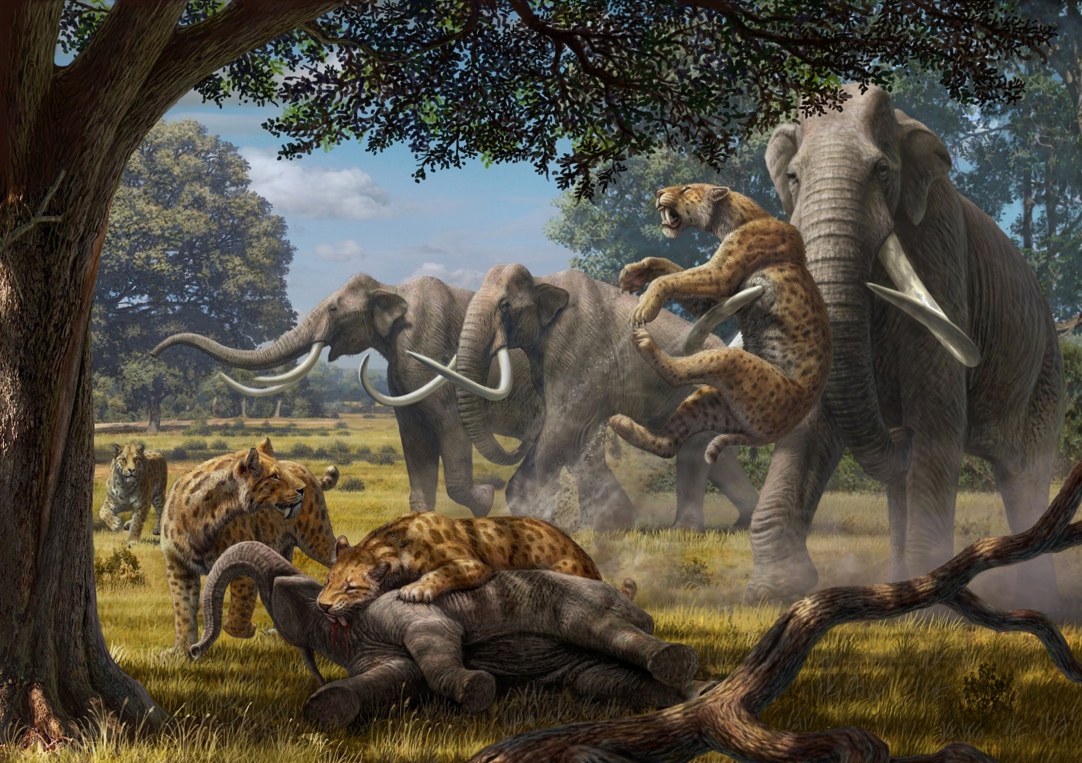Ancient Super-Predators Could Take Down Young Mammoths

Nearly a million years ago, a cave hyena could have taken down a 5-year-old mastodon weighing more than a ton. And in packs, the predators may have been equipped to demolish a 9-year-old mastodon weighing a hefty 2 tons.
That's according to new computer models that can calculate how big a target an ancient hypercarnivore, such as the cave hyena and the saber-toothed cat that rely solely on meat for sustenance, might have tackled, researchers say.
These findings show how ancient super-predators far larger than the wolves, lions and hyenas of today once kept megaherbivores such as mammoths, mastodons and giant ground sloths in check, researchers said. [Photos: Autopsy of a 40,000-Year-Old Mammoth]
"The probable role these large predators played in maintaining stable ecosystems hasn't been recognized until now," said the study's lead author, Blaire Van Valkenburgh, an evolutionary biologist at the University of California, Los Angeles.
Herbivores in check
Nowadays large herbivores such as elephants and white-tailed deer can have devastating effects on the environment by stripping it of vegetation through overgrazing (eating ground plants) or overbrowsing (eating leaves off trees). This brings up the question of what prevented widespread habitat destruction in the Pleistocene epoch, which lasted from about 1 million to 11,000 years ago. Back then, a much greater diversity of megaherbivores — plant-eaters 1,760 lbs. (800 kilograms) and larger — roamed the Earth.
Modern research suggests that current megaherbivores like elephants are largely immune to predators. However, scientists now find that ancient hypercarnivores had the ability to, and likely did, limit megaherbivore numbers.
Get the world’s most fascinating discoveries delivered straight to your inbox.
The impact of ancient hypercarnivores on past megaherbivores may have been difficult to appreciate because many extinct hypercarnivores such as saber-toothed cats have no close living counterparts, the researchers noted. This makes it difficult to deduce what they might have preyed on.
Still, the researchers noted there was once a much greater diversity of predators than exists today, many of which were significantly larger than their modern analogs — for the ones that do have analogs. This diversity suggests there was once intense competition between these carnivores, perhaps leading some to specialize in hunting megaherbivores.
Pleistocene teeth
To deduce the potential impact of ancient hypercarnivores, the researchers analyzed the fossil record to gauge size ranges for Pleistocene predators larger than about 45 lbs. (21 kg). Whereas modern hypercarnivores average 116 to 138 lbs. (53 to 63 kg), fossil hypercarnivores spanned 211 to 297 lbs. (96 to 135 kg) on average.
"Scientists didn't really understand how much bigger some of these Pleistocene predators were than modern ones," Van Valkenburgh told Live Science.
Previous research then helped the scientists develop estimates of an animal's size based on just its first molar. "In the fossil record, the one thing we've got a lot of is teeth," Van Valkenburgh said in a statement.
The researchers next estimated the sizes of ancient mammoths and mastodons. To do so, they developed mathematical formulas for the relationship of shoulder height to body mass from previous research on modern captive elephants.
By looking at the sizes of modern carnivores and the preferred sizes of their victims, the scientists then estimated what sizes of prey ancient predators might have targeted. They concluded that juvenile mastodons and mammoths would have been susceptible to many past hypercarnivores, especially ones that hunted in groups such as prides, clans and packs.
Indirect evidence that ancient predators hunted in larger groups than they do today may come from fossil teeth. Among modern carnivores, when competition over prey is high, prey is more difficult to capture, and carnivores make the most out of carcasses by eating more bone, leading to higher rates of broken teeth. When it came to large predators of the New World during the Pleistocene, tooth fracture rates were as much as three to five times that of their modern counterparts, suggesting higher densities of predators to prey than seen now.
"The group sizes of predators were considerably larger in the past than they are today, which would have made it easier for them to take down large prey," Van Valkenburgh said.
More work is needed to reconstruct Pleistocene ecosystems, "which were clearly hugely different from today," Van Valkenburgh said. "By understanding what we lost, what the productivity of the planet was, we can learn more about the time in which our species evolved and maybe why we've done so well."
Van Valkenburgh and her colleagues detailed their findings online today (Oct. 26) in the journal Proceedings of the National Academy of Sciences.
Follow us @livescience, Facebook & Google+. Original article on Live Science.

